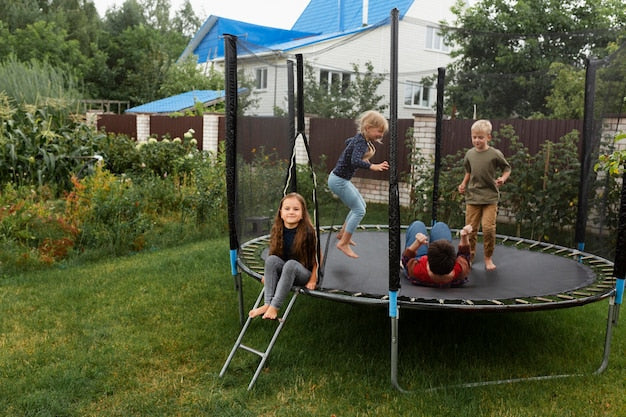Trampolines are a popular outdoor activity that can provide hours of fun and entertainment for children.
However, it's important to prioritize safety to prevent accidents and injuries. In this article, we'll discuss essential tips and guidelines to ensure trampoline safety for children. By following these precautions, you can create a safe environment for your kids to enjoy bouncing on the trampoline while minimizing the risk of accidents.
Understanding the Risks
The Potential for Injuries
While trampolines offer a thrilling experience, they also come with inherent risks. The repetitive bouncing motion can lead to sprains, strains, fractures, and even more severe injuries like head and neck injuries. Understanding these risks is crucial in taking the necessary precautions to prevent accidents.
Age and Size Considerations
Young children, particularly those under the age of six, are more susceptible to injuries on trampolines due to their developing motor skills and lack of coordination. Additionally, the size of the child in relation to the trampoline can also affect safety. It's important to consider age and size when determining whether a child is ready to use a trampoline.
trampoline.
Trampoline Safety Guidelines
Adult Supervision
One of the most important aspects of trampoline safety is having adult supervision at all times. An adult should be present to monitor the children, enforce safety rules, and provide assistance if needed. Never allow unsupervised jumping, as this significantly increases the risk of accidents.
Proper Installation and Maintenance
Ensure that the trampoline is properly installed according to the manufacturer's instructions. Regularly inspect the trampoline for any signs of wear, damage, or loose parts. Address any issues promptly and avoid using a trampoline that is in disrepair.
Use Safety Enclosures and Padding
Invest in a trampoline that comes with safety enclosures to prevent children from falling off the trampoline. The enclosures should be properly secured and in good condition. Additionally, consider using padding to cover the springs, frame, and other hard surfaces to reduce the risk of impact injuries.
Establish Trampoline Rules
Set clear and comprehensive rules for trampoline usage and make sure all children using the trampoline understand and follow them. Some important rules may include:
- No somersaults or flips unless under professional supervision.
- Only one person jumping at a time.
- No pushing or rough play.
- No jumping off the trampoline onto other surfaces.
Teach Safe Jumping Techniques
Educate children on safe jumping techniques to minimize the risk of injuries. Encourage them to jump in the center of the trampoline, maintain control of their movements, and avoid jumping too high or near the edges.
Limit Jumping Time
Prolonged jumping sessions can lead to fatigue, which increases the chances of accidents. Establish time limits for trampoline use based on the age and stamina of the child. Encourage regular breaks to prevent overexertion.
FAQs about Trampoline Safety
Q: Can trampolines be completely safe for children?
A: While it's not possible to eliminate all risks associated with trampolines, following safety guidelines and precautions significantly reduces the chances of accidents and injuries. Proper adult supervision, age-appropriate usage, and adherence to safety rules can help create a safer trampoline experience for children.
Q: At what age can children start using a trampoline?
A: The American Academy of Pediatrics recommends against trampoline use for children under the age of six due to safety concerns. Children's coordination, motor skills, and ability to follow safety rules improve as they grow older, reducing the risk of accidents.
Q: Are there alternative activities for children that provide similar benefits without the risks of trampolines?
A: Yes, there are several alternative activities that can provide similar benefits to trampolining. Consider options such as supervised gymnastics classes, dance lessons, or other forms of physical activity that promote coordination, strength, and balance.
Q: Can safety accessories like helmets and knee pads be used on trampolines?
A: While safety accessories like helmets and knee pads can provide some protection, they are not sufficient to prevent all injuries associated with trampolines. These accessories should not be seen as a substitute for following proper safety guidelines and supervision.
Q: What should I do if my child sustains an injury while using the trampoline?
A: If your child sustains an injury while using the trampoline, assess the severity of the injury. For minor injuries, provide appropriate first aid, such as cleaning wounds or applying ice packs for swelling. For more serious injuries, seek medical attention immediately.
Q: Are there any specific exercises or warm-ups that can help prevent trampoline-related injuries?
A: Engaging in regular physical activity and exercises that promote strength, flexibility, and coordination can contribute to injury prevention. Warm-up exercises before trampoline use can help prepare the body for the activity.
Conclusion
Trampolines can provide a fun and enjoyable experience for children, but it's crucial to prioritize safety. By following the guidelines outlined in this article, you can create a safer trampoline environment for your children, minimizing the risk of accidents and injuries. Remember, adult supervision, proper installation and maintenance, safety enclosures, and teaching safe jumping techniques are essential in ensuring a positive trampoline experience for your family. Stay vigilant, establish rules, and prioritize the well-being of your children while they enjoy this exciting outdoor activity.
Read more online here https://4akid.co.za/blogs/4akid/trampolines-what-you-need-to-know










